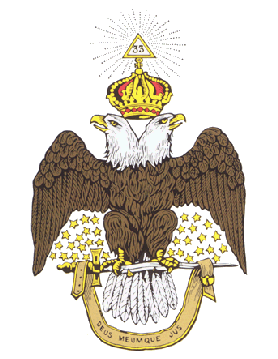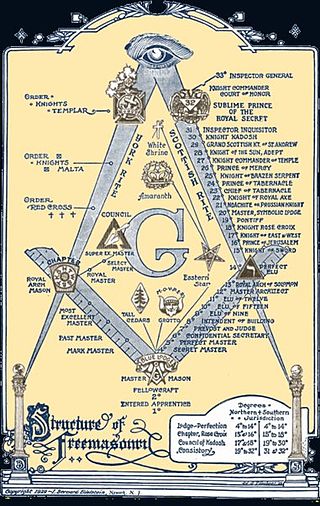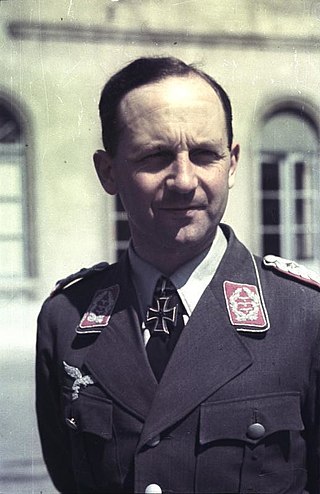
The Order of the Eastern Star is a Masonic appendant body open to both men and women. It was established in 1850 by lawyer and educator Rob Morris, a noted Freemason, and adopted and approved as an appendant body of the Masonic Fraternity in 1873. The order is based on some teachings from the Bible, and is open to people of all religious beliefs. It has approximately 10,000 chapters in 18 countries and approximately 500,000 members under its General Grand Chapter.

The Ancient and Accepted Scottish Rite of Freemasonry is a Rite within the broader context of Freemasonry. It is the most widely practiced Rite in the world. In some parts of the world, and in the Droit Humain, it is a concordant body and oversees all degrees from the 1st to 33rd degrees, while in other areas, a Supreme Council oversees the 4th to 33rd degrees.
The York Rite, sometimes referred to as the American Rite, is one of several Rites of Freemasonry. It is named for, but not practiced in, York, Yorkshire, England. A Rite is a series of progressive degrees that are conferred by various Masonic organizations or bodies, each of which operates under the control of its own central authority. The York Rite specifically is a collection of separate Masonic Bodies and associated Degrees that would otherwise operate independently. The three primary bodies in the York Rite are the Chapter of Royal Arch Masons, Council of Royal & Select Masters or Council of Cryptic Masons, and the Commandery of Knights Templar, each of which are governed independently but are all considered to be a part of the York Rite. There are also other organizations that are considered to be directly associated with the York Rite, or require York Rite membership to join such as the York Rite Sovereign College but in general the York Rite is considered to be made up of the aforementioned three. The Rite's name is derived from the city of York, where, according to one Masonic legend, the first meetings of Masons in England took place.

The Societas Rosicruciana is a Rosicrucian order which limits its membership to Christian Master Masons. The order was founded in Scotland, but now exists in Scotland, England, Canada, Portugal, and the United States. While a prospective member must be a Trinitarian Christian Master Mason in good standing with a Grand Lodge that is recognized by the Grand Lodge of the jurisdiction in which the Society meets, the various Societies have no other Masonic links, ties, or official recognition. Additionally, in some jurisdictions, membership is by invitation only. As the Society offers assistance to all its members in working out the great problems of nature and science, it functions in some respects as a research society.

DeMolay International is an international fraternal organization for young men ages 12 to 21. There is in some select area a "Squire" program for those younger than 12. It was founded in Kansas City, Missouri, in 1919 and named for Jacques de Molay, the last Grand Master of the Knights Templar. DeMolay was incorporated in the 1990s and is classified by the IRS as a tax-exempt 501(c)(3) organization.
Job's Daughters International is a Masonic affiliated youth organization for girls and young women aged 10 to 20. The organization is commonly referred to as simply Job's Daughters or Jobies, and sometimes abbreviated as JDI. Job's Daughters welcomes many religions and cultures. The only religious prerequisite is a belief in a Supreme being.
The Order of the Amaranth is a Masonic-affiliated organization for Master Masons and their Ladies founded in 1873. As in the Order of the Eastern Star, members of the Order must be age 18 and older; men must be Master Masons; and women must be related to Masons as wives, mothers, daughters, widows, sisters, nieces, aunts, et cetera, or have been active members of the International Order of the Rainbow for Girls or Job's Daughters International for more than three years and be recommended by a Master Mason.

Edward Young, Baron Young of Old Windsor, is a British courtier who served as Private Secretary to the Sovereign from 2017 to 2023. In this role, he was the senior operational member of the Royal Households of the United Kingdom. Young was recruited to the Royal Household in 2004, serving as Queen Elizabeth II's assistant and then as deputy private secretary until his promotion to private secretary in 2017. After the death of Elizabeth II in 2022, Young served as joint principal private secretary to King Charles III until he stepped down in May 2023.

The Knights Templar, full name The United Religious, Military and Masonic Orders of the Temple and of St John of Jerusalem, Palestine, Rhodes and Malta, is a fraternal order affiliated with Freemasonry. Unlike the initial degrees conferred in a regular Masonic Lodge, which only require a belief in a Supreme Being regardless of religious affiliation, the Knights Templar is one of several additional Masonic Orders in which membership is open only to Freemasons who profess a belief in Christianity. One of the obligations entrants to the order are required to declare is to protect and defend the Christian faith. The word "United" in its full title indicates that more than one historical tradition and more than one actual order are jointly controlled within this system. The individual orders 'united' within this system are principally the Knights of the Temple, the Knights of Malta, the Knights of St Paul, and only within the York Rite, the Knights of the Red Cross.

There are many organisations and orders which form part of the widespread fraternity of Freemasonry, each having its own structure and terminology. Collectively these may be referred to as Masonic bodies, Masonic orders, Concordant bodies or appendant bodies of Freemasonry.

Alexandre Francois Auguste de Grasse, known as Auguste de Grasse and Comte de Grasse-Tilly, was a French career army officer. He was assigned to the French colony of Saint-Domingue in 1789, where he married in Cap Français, and acquired a plantation and 200 slaves before the Haitian Revolution. Following the Royal Navy's defeat of the French fleet in Saint-Domingue in 1793, de Grasse was allowed to resign his commission and leave with his family and in-laws for Charleston, South Carolina.
In Craft Freemasonry, sometimes known as Blue Lodge Freemasonry, every Masonic lodge elects or appoints Masonic lodge officers to execute the necessary functions of the lodge's life and work. The precise list of such offices may vary between the jurisdictions of different Grand Lodges, although certain factors are common to all, and others are usual in most.
The Allied Masonic Degrees (AMD) are a series of Masonic degrees conferred by Councils of the Allied Masonic Degrees. The Allied Masonic Degrees form an appendant order of Freemasonry that exists in some Masonic jurisdictions; its degrees are conferred only by invitation. Councils of the Allied Masonic Degrees exist in Great Britain, the United States, Canada, France, Australia, India, Benin and Congo, and their members also educate one another by presenting research papers on Freemasonry.

Heinrich "Heinz" Trettner was a German general who served in the Spanish Civil War, and during World War II and the Cold War. From 1964 to 1966, he served as Inspector General of the Bundeswehr, the head of the military of the Federal Republic of Germany. He was the last living general of the Wehrmacht.

The Squire Roses are a youth sorority run by individual State Councils within the Knights of Columbus, for Catholic girls between the ages of 10 and 18.

The International Temple, Supreme Assembly, Order of the Rainbow for Girls is a building in McAlester, Oklahoma, United States that serves as the headquarters for the International Order of the Rainbow for Girls. It was listed on the National Register of Historic Places on July 14, 2013.
The Pythian Sisters is a fraternal order with members throughout the United States and Canada. Although affiliated with the Knights of Pythias, they are not an auxiliary group as they have their own charter. The Pythian Sisters provided sick and death benefits to members.
Freemasonry in Scotland in lodges chartered by the Grand Lodge of Scotland comprises the Scottish Masonic Constitution as regular Masonic jurisdiction for the majority of freemasons in Scotland. There are also lodges operating under the Scottish Masonic Constitution in countries outside of Scotland. Many of these are countries linked to Scotland and the United Kingdom through the Commonwealth of Nations and prior colonies and other settlements of the British Empire although there are several lodges in countries such as Lebanon, Belgium, Chile and Peru, which do not have such connections.
The Supreme Council, Scottish Rite, Northern Jurisdiction oversees the Scottish Rite of Freemasonry in fifteen states: Connecticut, Delaware, Illinois, Indiana, Maine, Massachusetts, Michigan, New Jersey, New Hampshire, New York, Ohio, Pennsylvania, Rhode Island, Wisconsin and Vermont. This territory has existed since 1827 when the NMJ gained jurisdiction "over the then 14 states situated east of the Mississippi and north of the Mason-Dixon Line. Wisconsin was not yet a state, but part of Michigan."












